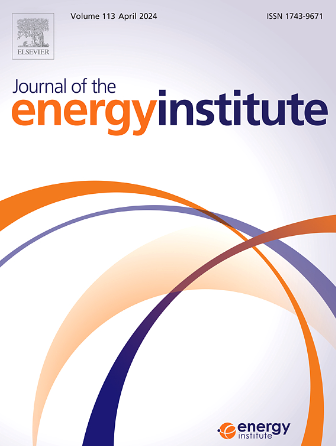废轮胎热解特性及高值油研究:热解参数及催化剂的影响
IF 5.6
2区 工程技术
Q2 ENERGY & FUELS
引用次数: 0
摘要
热解是一种绿色高效的废轮胎处理方法,但热解产物的复杂性限制了其高价值利用。为了提高热解产物特别是热解油的价值,本文通过热重(TG)实验和热解气相色谱-质谱(Py-GC/MS)技术对废轮胎的热解过程进行了研究。通过固定床实验,研究了热解温度、升温速率、原料粒度和催化剂对废轮胎热解产物的影响。结果表明:废轮胎的热解过程可分为三个阶段,随着温度的升高,助剂、橡胶和大分子物质依次发生热解;通过对比实验,我们发现快速热解、较低温度和较小粒径最有利于油品的形成和品质的提高。ZSM-5和SAPO-34均能提高烯烃和环烯烃含量,降低单环芳烃(MAHs)含量。与ZSM-5相比,SAPO-34具有更强的酸性位点和更多的微孔,具有更好的催化效果。本研究为产品的高价值利用和目标产品的针对性调控提供了理论依据。本文章由计算机程序翻译,如有差异,请以英文原文为准。

Study on waste tires pyrolysis characteristics and high-value oil: Effects of pyrolysis parameters and catalyst
Pyrolysis is a green and efficient way to treat waste tires, but the complexity of pyrolysis products limits its high value utilization. To improve the value of pyrolysis products, especially pyrolysis oil, herein the pyrolysis process of waste tire was studied through thermogravimetry (TG) experiment and Pyrolysis gas chromatography-mass spectrometry (Py-GC/MS). The effects of pyrolysis temperature, heating rate, raw material particle size and catalyst on the pyrolysis products of waste tire were studied through fixed bed experiments. The results showed that the pyrolysis process of waste tire could be divided into three stages, additives, rubber and macromolecular substances pyrolyze in turn with the increase of temperature. After conducting comparative experiments, we discovered that rapid pyrolysis, lower temperature and smaller particle size were the most favorable for the formation and quality improvement of the oil. Both ZSM-5 and SAPO-34 could increase the olefins and cycloolefins contents and decrease the Monocyclic aromatic hydrocarbons (MAHs) content. SAPO-34 had stronger acidic site and more micropores compared with ZSM-5, which showed a better catalytic effect. This study provides a theoretical basis for the high value utilization of products and the targeted regulation of target products.
求助全文
通过发布文献求助,成功后即可免费获取论文全文。
去求助
来源期刊

Journal of The Energy Institute
工程技术-能源与燃料
CiteScore
10.60
自引率
5.30%
发文量
166
审稿时长
16 days
期刊介绍:
The Journal of the Energy Institute provides peer reviewed coverage of original high quality research on energy, engineering and technology.The coverage is broad and the main areas of interest include:
Combustion engineering and associated technologies; process heating; power generation; engines and propulsion; emissions and environmental pollution control; clean coal technologies; carbon abatement technologies
Emissions and environmental pollution control; safety and hazards;
Clean coal technologies; carbon abatement technologies, including carbon capture and storage, CCS;
Petroleum engineering and fuel quality, including storage and transport
Alternative energy sources; biomass utilisation and biomass conversion technologies; energy from waste, incineration and recycling
Energy conversion, energy recovery and energy efficiency; space heating, fuel cells, heat pumps and cooling systems
Energy storage
The journal''s coverage reflects changes in energy technology that result from the transition to more efficient energy production and end use together with reduced carbon emission.
 求助内容:
求助内容: 应助结果提醒方式:
应助结果提醒方式:


